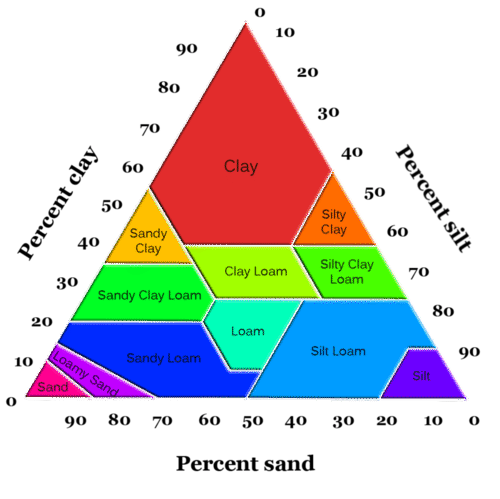13.6: Soil Characteristics
- Page ID
- 5555
\( \newcommand{\vecs}[1]{\overset { \scriptstyle \rightharpoonup} {\mathbf{#1}} } \)
\( \newcommand{\vecd}[1]{\overset{-\!-\!\rightharpoonup}{\vphantom{a}\smash {#1}}} \)
\( \newcommand{\dsum}{\displaystyle\sum\limits} \)
\( \newcommand{\dint}{\displaystyle\int\limits} \)
\( \newcommand{\dlim}{\displaystyle\lim\limits} \)
\( \newcommand{\id}{\mathrm{id}}\) \( \newcommand{\Span}{\mathrm{span}}\)
( \newcommand{\kernel}{\mathrm{null}\,}\) \( \newcommand{\range}{\mathrm{range}\,}\)
\( \newcommand{\RealPart}{\mathrm{Re}}\) \( \newcommand{\ImaginaryPart}{\mathrm{Im}}\)
\( \newcommand{\Argument}{\mathrm{Arg}}\) \( \newcommand{\norm}[1]{\| #1 \|}\)
\( \newcommand{\inner}[2]{\langle #1, #2 \rangle}\)
\( \newcommand{\Span}{\mathrm{span}}\)
\( \newcommand{\id}{\mathrm{id}}\)
\( \newcommand{\Span}{\mathrm{span}}\)
\( \newcommand{\kernel}{\mathrm{null}\,}\)
\( \newcommand{\range}{\mathrm{range}\,}\)
\( \newcommand{\RealPart}{\mathrm{Re}}\)
\( \newcommand{\ImaginaryPart}{\mathrm{Im}}\)
\( \newcommand{\Argument}{\mathrm{Arg}}\)
\( \newcommand{\norm}[1]{\| #1 \|}\)
\( \newcommand{\inner}[2]{\langle #1, #2 \rangle}\)
\( \newcommand{\Span}{\mathrm{span}}\) \( \newcommand{\AA}{\unicode[.8,0]{x212B}}\)
\( \newcommand{\vectorA}[1]{\vec{#1}} % arrow\)
\( \newcommand{\vectorAt}[1]{\vec{\text{#1}}} % arrow\)
\( \newcommand{\vectorB}[1]{\overset { \scriptstyle \rightharpoonup} {\mathbf{#1}} } \)
\( \newcommand{\vectorC}[1]{\textbf{#1}} \)
\( \newcommand{\vectorD}[1]{\overrightarrow{#1}} \)
\( \newcommand{\vectorDt}[1]{\overrightarrow{\text{#1}}} \)
\( \newcommand{\vectE}[1]{\overset{-\!-\!\rightharpoonup}{\vphantom{a}\smash{\mathbf {#1}}}} \)
\( \newcommand{\vecs}[1]{\overset { \scriptstyle \rightharpoonup} {\mathbf{#1}} } \)
\(\newcommand{\longvect}{\overrightarrow}\)
\( \newcommand{\vecd}[1]{\overset{-\!-\!\rightharpoonup}{\vphantom{a}\smash {#1}}} \)
\(\newcommand{\avec}{\mathbf a}\) \(\newcommand{\bvec}{\mathbf b}\) \(\newcommand{\cvec}{\mathbf c}\) \(\newcommand{\dvec}{\mathbf d}\) \(\newcommand{\dtil}{\widetilde{\mathbf d}}\) \(\newcommand{\evec}{\mathbf e}\) \(\newcommand{\fvec}{\mathbf f}\) \(\newcommand{\nvec}{\mathbf n}\) \(\newcommand{\pvec}{\mathbf p}\) \(\newcommand{\qvec}{\mathbf q}\) \(\newcommand{\svec}{\mathbf s}\) \(\newcommand{\tvec}{\mathbf t}\) \(\newcommand{\uvec}{\mathbf u}\) \(\newcommand{\vvec}{\mathbf v}\) \(\newcommand{\wvec}{\mathbf w}\) \(\newcommand{\xvec}{\mathbf x}\) \(\newcommand{\yvec}{\mathbf y}\) \(\newcommand{\zvec}{\mathbf z}\) \(\newcommand{\rvec}{\mathbf r}\) \(\newcommand{\mvec}{\mathbf m}\) \(\newcommand{\zerovec}{\mathbf 0}\) \(\newcommand{\onevec}{\mathbf 1}\) \(\newcommand{\real}{\mathbb R}\) \(\newcommand{\twovec}[2]{\left[\begin{array}{r}#1 \\ #2 \end{array}\right]}\) \(\newcommand{\ctwovec}[2]{\left[\begin{array}{c}#1 \\ #2 \end{array}\right]}\) \(\newcommand{\threevec}[3]{\left[\begin{array}{r}#1 \\ #2 \\ #3 \end{array}\right]}\) \(\newcommand{\cthreevec}[3]{\left[\begin{array}{c}#1 \\ #2 \\ #3 \end{array}\right]}\) \(\newcommand{\fourvec}[4]{\left[\begin{array}{r}#1 \\ #2 \\ #3 \\ #4 \end{array}\right]}\) \(\newcommand{\cfourvec}[4]{\left[\begin{array}{c}#1 \\ #2 \\ #3 \\ #4 \end{array}\right]}\) \(\newcommand{\fivevec}[5]{\left[\begin{array}{r}#1 \\ #2 \\ #3 \\ #4 \\ #5 \\ \end{array}\right]}\) \(\newcommand{\cfivevec}[5]{\left[\begin{array}{c}#1 \\ #2 \\ #3 \\ #4 \\ #5 \\ \end{array}\right]}\) \(\newcommand{\mattwo}[4]{\left[\begin{array}{rr}#1 \amp #2 \\ #3 \amp #4 \\ \end{array}\right]}\) \(\newcommand{\laspan}[1]{\text{Span}\{#1\}}\) \(\newcommand{\bcal}{\cal B}\) \(\newcommand{\ccal}{\cal C}\) \(\newcommand{\scal}{\cal S}\) \(\newcommand{\wcal}{\cal W}\) \(\newcommand{\ecal}{\cal E}\) \(\newcommand{\coords}[2]{\left\{#1\right\}_{#2}}\) \(\newcommand{\gray}[1]{\color{gray}{#1}}\) \(\newcommand{\lgray}[1]{\color{lightgray}{#1}}\) \(\newcommand{\rank}{\operatorname{rank}}\) \(\newcommand{\row}{\text{Row}}\) \(\newcommand{\col}{\text{Col}}\) \(\renewcommand{\row}{\text{Row}}\) \(\newcommand{\nul}{\text{Nul}}\) \(\newcommand{\var}{\text{Var}}\) \(\newcommand{\corr}{\text{corr}}\) \(\newcommand{\len}[1]{\left|#1\right|}\) \(\newcommand{\bbar}{\overline{\bvec}}\) \(\newcommand{\bhat}{\widehat{\bvec}}\) \(\newcommand{\bperp}{\bvec^\perp}\) \(\newcommand{\xhat}{\widehat{\xvec}}\) \(\newcommand{\vhat}{\widehat{\vvec}}\) \(\newcommand{\uhat}{\widehat{\uvec}}\) \(\newcommand{\what}{\widehat{\wvec}}\) \(\newcommand{\Sighat}{\widehat{\Sigma}}\) \(\newcommand{\lt}{<}\) \(\newcommand{\gt}{>}\) \(\newcommand{\amp}{&}\) \(\definecolor{fillinmathshade}{gray}{0.9}\)How does soil resemble weathered rock?
The same processes that weather rock create soil. A large part of soil is weathered rock! If weathering processes didn't exist on earth we would have no soil. Earth wouldn't be a very good place to live. There would be very limited plant life and not much way to grow crops.
The Importance of Soil
You learned in the previous concept that weathering produces sediment. Weathering also produces soil.
People could not live on earth without soil! Your life and the lives of many land organisms depend on soil. Soil is only a very thin layer over solid rock. Yet, it is the place where reactions between solid rock, liquid water and air take place. Soil anchors plant roots and provides them with water and nutrients. We get wood, paper, cotton, medicines, and even pure water from soil. So soil is a very important resource. Our precious soil needs to be carefully managed and cared for. If we don’t take care of the soil we have, we may not be able to use it in the future.
Characteristics of Soil
Soil is a complex mixture of different materials.
- Some of them are inorganic. Inorganic materials are made from non-living substances like pebbles and sand.
- Soil also contains bits of organic materials from plants and animals.
In general, about half of the soil is made of pieces of rock and minerals. The other half is organic materials.
In some soils, the organic portion is entirely missing. This is true of desert sand. At the other extreme, a soil may be completely organic. Peat, found in a bog or swamp, is totally organic soil. Organic materials are necessary for a soil to be fertile. The organic portion provides the nutrients needed for strong plant growth.
Soil Texture
The inorganic portion of soil is made of many different size particles. These different size particles are present in different proportions. The sizes and proportions of particles determines some of the properties of the soil.
- Water can flow easily through a permeable soil. Spaces between the inorganic particles are large and well connected. Sandy or silty soils are permeable, water-draining types of soils.
- Soils with lots of very small spaces are water-holding soils. When clay is present in a soil, the soil holds together more tightly. Clay-rich soil can hold more water.
- When a soil contains a mixture of grain sizes, the soil is called a loam (Figure below).
Two layers of soil are shown here. A sandy soil is at the bottom. A soil with more clay is at the top.
Classification
Soil scientists classify soil by measuring the percentage of sand, silt, and clay. They plot this information on a triangular diagram. Each size particle is at one corner (Figure below). The soil type is then known from the location on the diagram. At the top, a soil would be clay; at the left corner, it would be sand; at the right corner, it would be silt. Soils in the lower middle with less than 50% clay are loams.
Soil types by particle size.
Further Reading
Soil Formation
Soil Horizons and Profiles
Types of Soils
Soil Erosion
Avoiding Soil Loss
Summary
- Soil reflects the interactions between the lithosphere, atmosphere, hydrosphere, and biosphere.
- Permeable soils allow water to flow through.
- The proportions of silt, clay, and sand allow scientists to classify soil type.
Review
- What are the inorganic materials that make up a soil?
- What are the organic materials that make up a soil?
- In what environment are there no organic materials in soils? What soils are nearly all organic?
- How are living organisms important to soil?
Explore More
Use the resource below to answer the questions that follow.
- Why is soil important?
- How many different types of soils are there? What is the composition of average soil?
- What is humus?
- What does the amount of humus determine?
- How can texture affect plant growth?
- What type of soil do farmers prefer?
- How much soil being lost each year in the U.S.?
- Describe the different types of erosion.





